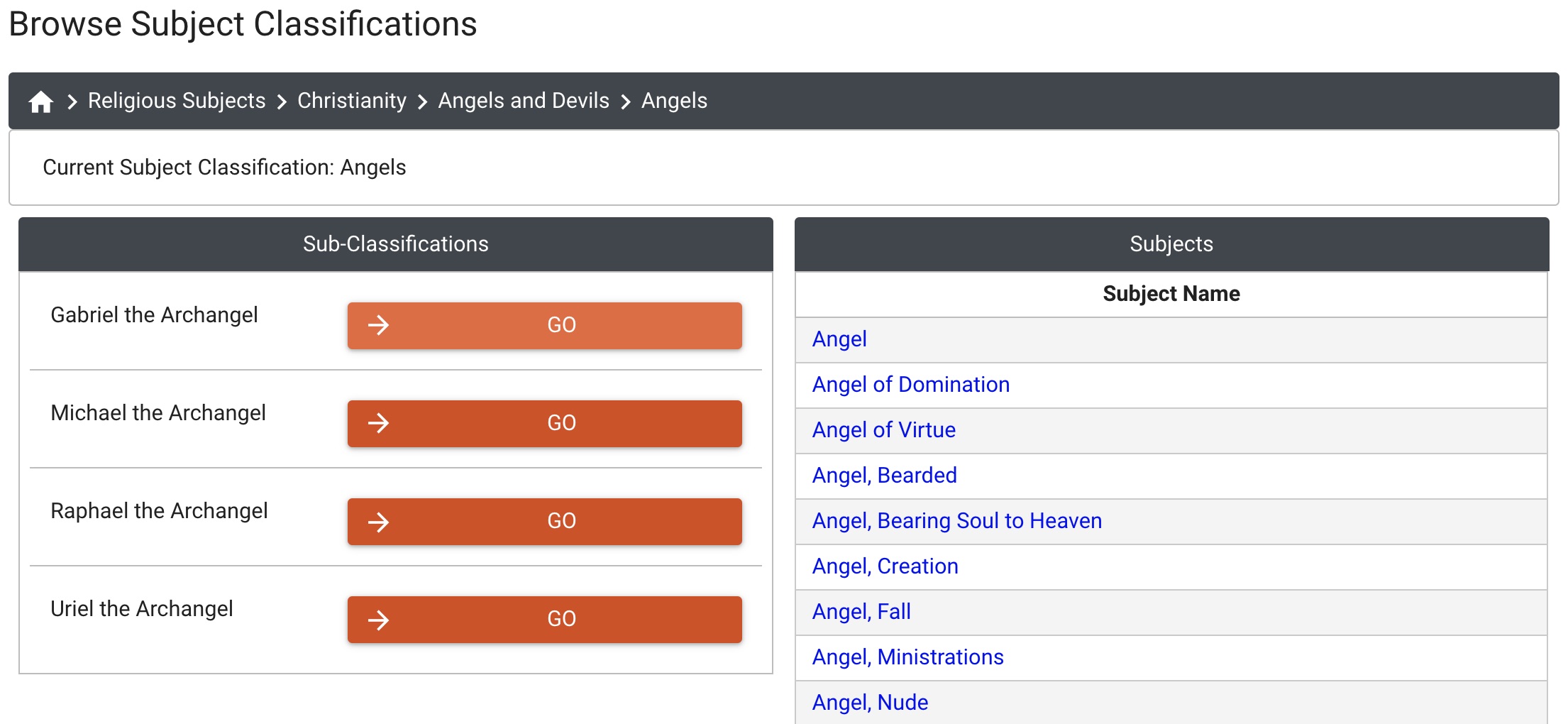

The Index is pleased to announce the launch of a new digital resource for the study of Byzantine iconography, the Lois Drewer Calendar of Saints in Byzantine Manuscripts and Frescoes. Compiled by the late Lois Drewer, PhD, longtime specialist in Byzantine art at the Index, this calendar identifies saints, cites standard and hagiographic references (with a guide to their abbreviations), and concisely describes manuscript illuminations and frescoes. The calendar is organized by feast days in the Constantinopolitan calendar.
There are four main ways to browse the resource. The first is by selecting a month and day under the tab for calendar. This entry point leads to the core of the data, and we recommend this as a good place to start. For example, searching today’s date of the fifth of March reveals three entries for saints: 1. Mark of Egypt; 2. Conon the Gardner; and 3. Hypatius of Gangra. The list you will find there offers identifications, references, and examples.
Many of the saints and holy martyrs included in Dr. Drewer’s calendar are obscure or infrequently represented in medieval art, such as Conon the Gardener (also known as Conon of Perga), a gardener from Nazareth martyred under the Roman emperor Decius (r. 249–251 CE).[1] In some cases, the iconography has not yet been cataloged by the Index, making this an especially useful additional resource.

There are also two lists for iconographic motifs and iconographic scenes with feast days linked on the right, and a list of feasts days organized A to Z. The iconographic motifs and scenes are grouped alphabetically beneath bold headings.
A majority of the headings in this resource cover martyrdom and torture scenes for Byzantine saints–among them holy martyrs, hermits, prophets, and women, but Drewer also included groups for various vestments and clothing, human gestures, attributes, and objects. For example, it is possible to see that an axe is associated with John the Baptist.
In some examples of medieval iconography, the preaching John the Baptist is depicted pointing to an axe at the base of a tree, a reference to Matthew 3:10. Or you can discover that the representation of grief is linked to Sophia of Rome, who is portrayed in various scenes as mournfully throwing out her arms in response to the beheadings of her daughters Pistis, Elpis, and Agape.
There is much to discover by browsing these lists, and we expect that this resource may usefully supplement your searches within the wider Index of Medieval Art Database. You may also try browsing the Svetlana Tomeković Database of Byzantine Art for similar themes represented in Byzantine art. We welcome your feedback, and we look forward to receiving questions through our research inquiries form.
We warmly thank the Index’s Technology Manager Jon Niola for bringing this project to fruition. Lois Drewer dedicated much of her life to iconographic research, and we feel certain that she would have approved of this posthumous tribute. We are proud to offer this additional resource so that all may benefit from Dr. Drewer’s calendar of saints.

[1] Drewer’s database notes three instances of the iconography of the holy martyr Conon the Gardener: a small illustrated Menologion, 1322-1340 (Oxford, Bodleian Library, MS. Gr. th. f. 1, fol. 30v), and two frescoes in the south aisle of the narthex in Dečani and in the dome of the south tower narthex in Treskavec, all of which have yet to be added to the Index database.
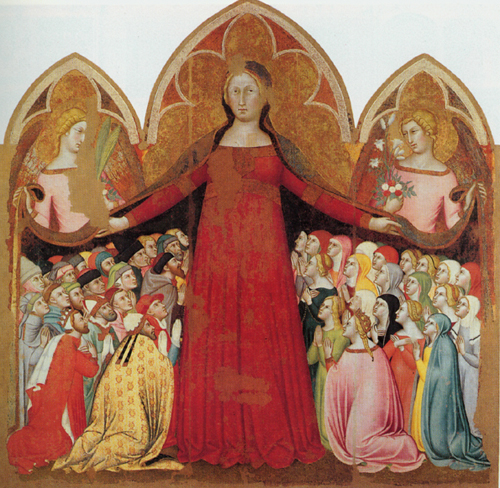
Please join us and register for the next virtual database tutorial with the Index on Tuesday, March 25, 2025 from 12:00 – 1:00 pm EST.
Read more about it at this link: https://ima.princeton.edu/index_training/.
We are very pleased to announce that Kyriaki Giannouli has joined the Index remotely for a three-month, part-time research opportunity to help incorporate key works on Mount Athos (Greece) into the database!
Kyriaki is a doctoral candidate specializing in Byzantine History at the University of Ioannina and a professional conservator of paintings. Her research focuses on examining the significance of Greek landscapes within the travelogues of Western Holy Land pilgrims from the 12th to the 17th centuries. She is an expert in Byzantine portable icons, frescoes, coins and seals and has hands-on experience in creating specialized conservation reports and working with databases.
At the Index, Kyriaki has started working on enamel and metalwork backfiles and has already made digitally available several objects on Mount Athos, including a fourteenth-century chalice from Vatopedi monastery (Index system number mar20240205001) and an eleventh-century book cover from Lavra monastery (Index system number mar20240212001). Her position requires her to examine the Index legacy records, update the metadata, identify new color images, and incorporate them into the online database. This will allow scholars worldwide, who are not able to travel to use the print Index on the Princeton campus, to access these images and their metadata. We are very excited and grateful to have Kyriaki join us in this collaboration!
This position is part of a multi-year project focusing on Mount Athos-related collections at Princeton (https://athoslegacy.project.princeton.edu/) and has been generously funded by the Seeger Center for Hellenic Studies with the support of the Dimitrios and Kalliopi Monoyios Modern Greek Studies Fund and Art & Archaeology Department at Princeton University.
As editorial staff at the Index continue cataloging our physical backfiles, which contain over 200,000 photographs of works of art in sixteen media categories, we are happy to announce that at last, all our print records of gold glass objects have been fully digitized in the Index database! In gold glass, an image in gold leaf is fused between layers of glass. Gold glass was a favored art form in Hellenistic Greece and during the Roman period, often decorating the bases of feasting vessels, such as bowls, cups, and plates, with hidden pictures that would slowly be revealed during the consumption of food and wine. The newly digitized “Gold Glass” backfiles document over 650 objects from about 60 locations. Most examples are identified as vessels, medallions, or plaques (Fig. 1).
The glittering portraits on these glass objects, now mostly fragmentary, are usually bust length and often show whole families. These are classified under the Index subject “Family Group,” while the subject “Married Pair” is used for images depicting a bride and groom, sometimes crowned by Christ. Gold glass objects are frequently associated with marriage celebrations, and several pieces retain the names of the men and women depicted with inscriptions of good wishes. Frequently, this inscription is the Latin drinking toast “PIE ZESES” (“Drink to live,”), either in full or abbreviated, although a fourth-century gold glass fragment from Rome, now in the British Museum, bears the more sentimental words “DVLCIS ANIMA VIVAS” (“Sweet soul, may you live [long]”) around the heads of the newlyweds (Fig. 2).
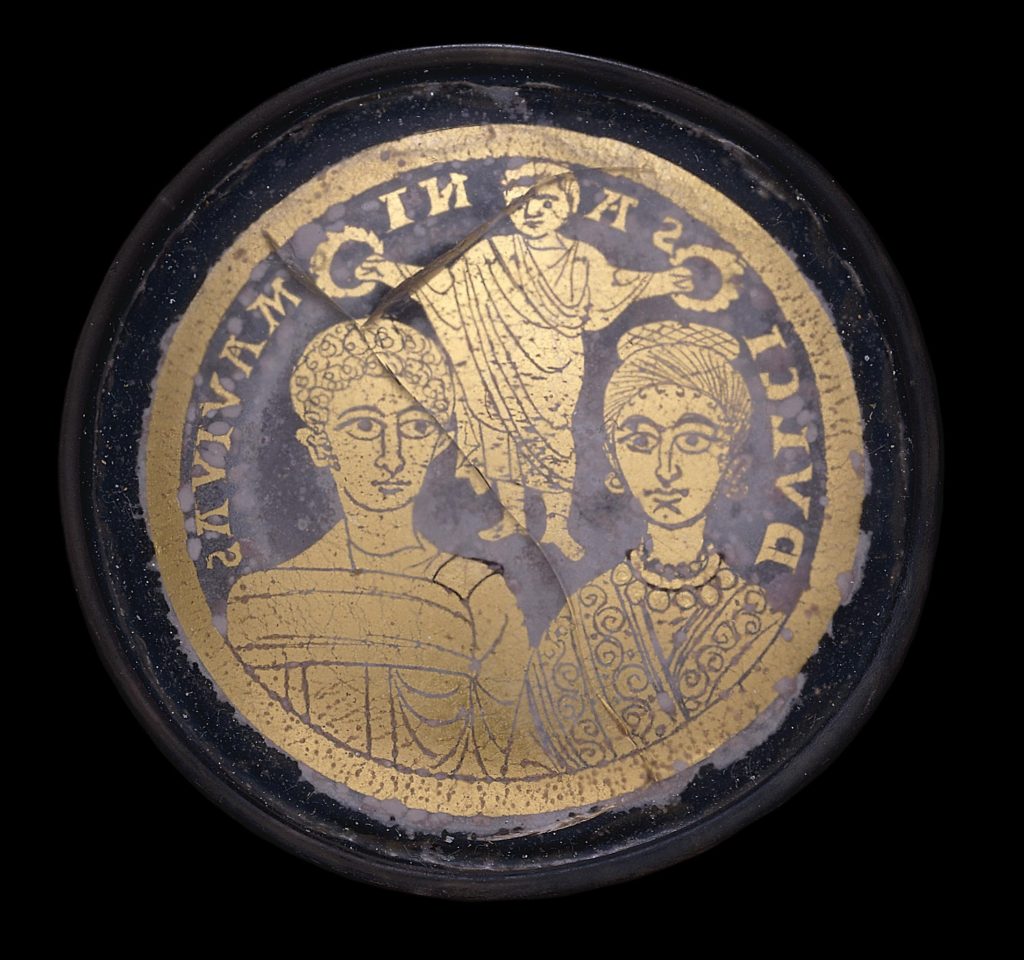
Several gold glass objects contain other paired figures, especially Peter and Paul the Apostles, as the patron saints of Rome, and Adam and Eve, commonly represented in the Fall of Man scene. Old Testament narratives and figures, such as Moses, Abraham, Daniel, and Jonah were popular, and Christian miracles were also frequently depicted on vessels. The Index database contains just over fifty miracle scenes executed in the gold glass medium, including the Raising of Lazarus, the Miracle of Loaves, and the Wedding at Cana, suggesting that healing themes held some favor among patrons. The objects may also have served a commemorative function.
Some surviving gold glass objects contain Jewish iconographic motifs, including the Temple implements, such as the menorah, shofar, etrog, and Torah Ark. These implements can be found in the Index database by browsing the Subject list, or by searching for “gold glass” as a term and filtering by the Style/Culture “Jewish.” Mythological figures and narratives from the classical world were also favored subjects to depict on gold glass vessels. The Herculean labors, sea-nymphs, and cupids can be identified on some fragments. Other well-represented motifs in the medium include the “Good Shepherd,” which has iconographic connections to the ancient Greek ram-bearing cult figure Kriophoros. There remains much to discover and assess about images in gold glass and their meanings, production, and patronage throughout the late antique, Roman, and Byzantine periods, making the Index an essential study tool. Now, with increased access, more researchers can learn how this rather fragile art form documents fashion, commerce, rituals, and historical names and epigraphs from ancient daily life (Fig. 3).
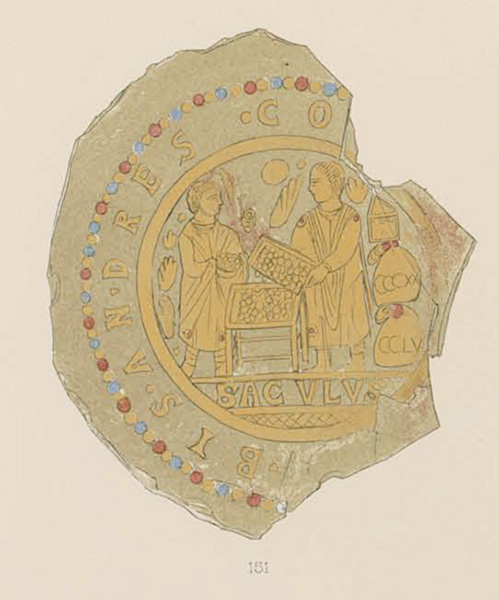
The Index gold glass backfiles received significant attention by Ryan Gerber, our 2019 summer intern from the Rutgers School of Communication, who is now a Marquand Art Library Collections Specialist. Gerber inventoried the collection and wrote about his impressions in a blog post called “A Face in Gold Glass.” After Henry D. Schilb, Index Art History Specialist in Byzantine Art, finished adding the collection with the help of Gerber’s inventory, he noted that many gold glass objects recorded in major nineteenth century catalogs did not survive into the modern era. Thus, the publications that earlier Index catalogers used in their research may have contained the last known record of an object’s existence. Schilb said, “it was surprising to learn that many of the gold glass objects entered into the Index files have been lost to time, and at least one of them was apparently reduced to dust in the collection where it was last recorded. Not surprisingly, we have also simply lost track of several examples that were originally cataloged by Indexers before the Second World War.” With too little information to go on, the Index cataloger can sometimes upload only a drawing from the catalog and record only a “Last Known Location” for objects presumed lost to history. When we just don’t know where something is, we indicate this in the database by giving “Unknown” as the current location with a “Last Known Location” to identify the place where an item was last known to exist. This can apply to items that we know to have been destroyed, but it also applies frequently to items that are either simply lost or are now in unidentified, private collections. Although the Index can sometimes discover an object’s true current location, that bit of data can sometimes elude us, so we always welcome intelligence from anyone who might have a good lead!
It is a great achievement when we can complete an entire category in the backfiles with newly researched information, including updated location names, fuller iconographic descriptions, and new or updated terms from Index vocabularies to expand the findability of work of art records. We ought to be clear, however, that we do not claim to have recorded every known example of any medium or type of object. That must remain an ongoing project. Nevertheless, the whole Index team is thrilled to make the gold glass corpus of the original Index card catalog fully available in the database. If you want to see for yourself, you can browse “gold glass” records by Medium more fully here: https://theindex.princeton.edu/s/list/ListMediums.action. You can also reach out to us with any inquiry here: https://ima.princeton.edu/research-inquiries/. Please let us know how the Index can improve the records we have, or find out how the Index can serve your own research needs.
Cheers!
Further Resources
Garrucci, Raffaele. Vetri ornati di figure in oro: Trovati nei cimiteri dei cristiani primitivi di roma. Rome: Tipografia Salviucci, 1858.
Deville, Achille. Histoire de l’art de la verrerie dans l’antiquité. Paris: Morel, 1871.
Vopel, Hermann. Die Altchristlichen Goldgläser: Ein Beitrag zur altchristlichen Kunst- und Kulturgeschichte. Freiburg im Breisgau: J. C. B. Mohr, 1899.
Morey, Charles Rufus. The Gold-Glass Collection of the Vatican Library: With Additional Catalogues of Other Gold-Glass Collections, ed. Guy Ferrari. Vatican City: Biblioteca apostolica vaticana, 1959.
Meek, Andrew. New Light on Old Glass: Recent Research on Byzantine Mosaics and Glass. London: British Museum Press, 2013.
Howells, Daniel Thomas. A Catalogue of the Late Antique Gold Glass in the British Museum. London, British Museum Press, 2015.
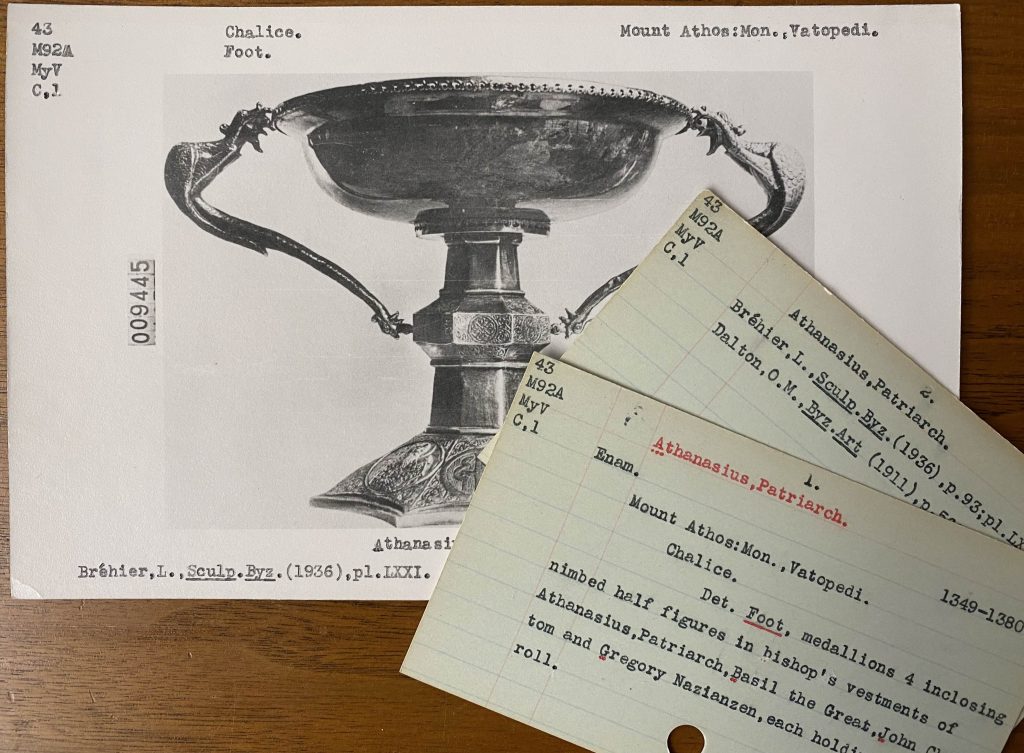
We are excited to announce a short-term graduate opportunity at the Index of Medieval Art! This is a two to three-month remote, part-time research opportunity to help incorporate key works of art on Mount Athos into the Index database. The position would require the student to examine the Index legacy records, update the metadata, identify new color images, and incorporate them into the online database. They will be trained in Index norms in cataloging works of art, describing the iconography, transcribing inscriptions, and adding bibliographic citations.
The position is part of a new multi-year project, Connecting Histories: The Princeton and Mount Athos Legacy, that aims to create an international team of faculty, staff, and students that will explore and bring awareness to the rich, complex, and remarkable historical and cultural heritage of Mount Athos, and its connection to Princeton. This opportunity offers a stipend of $2,500 and has been generously funded by the Seeger Center for Hellenic Studies, with the support of the Dimitrios and Kalliopi Monoyios Modern Greek Studies Fund and Art & Archaeology Department at Princeton University.
The deadline for applications is December 1, 2023. For more details about eligibility criteria and the application process, please visit the “Announcements” page on the Connecting Histories website.
We are excited to announce that the mosaics of St. Sophia Cathedral in Kyiv are now live in the Index database! Thanks to a Flash Grant from the Princeton University Humanities Council, Dr. Julia Matveyeva, Associate Professor in the Department of Fine Arts and Design of the O. M. Beketov National University of Urban Economy in Kharkiv, joined the Index remotely for the last five months to work on Ukraine’s medieval cultural heritage. Find out more about St. Sophia Cathedral, the work of an Index cataloger, and Dr. Matveyeva’s research at this link.
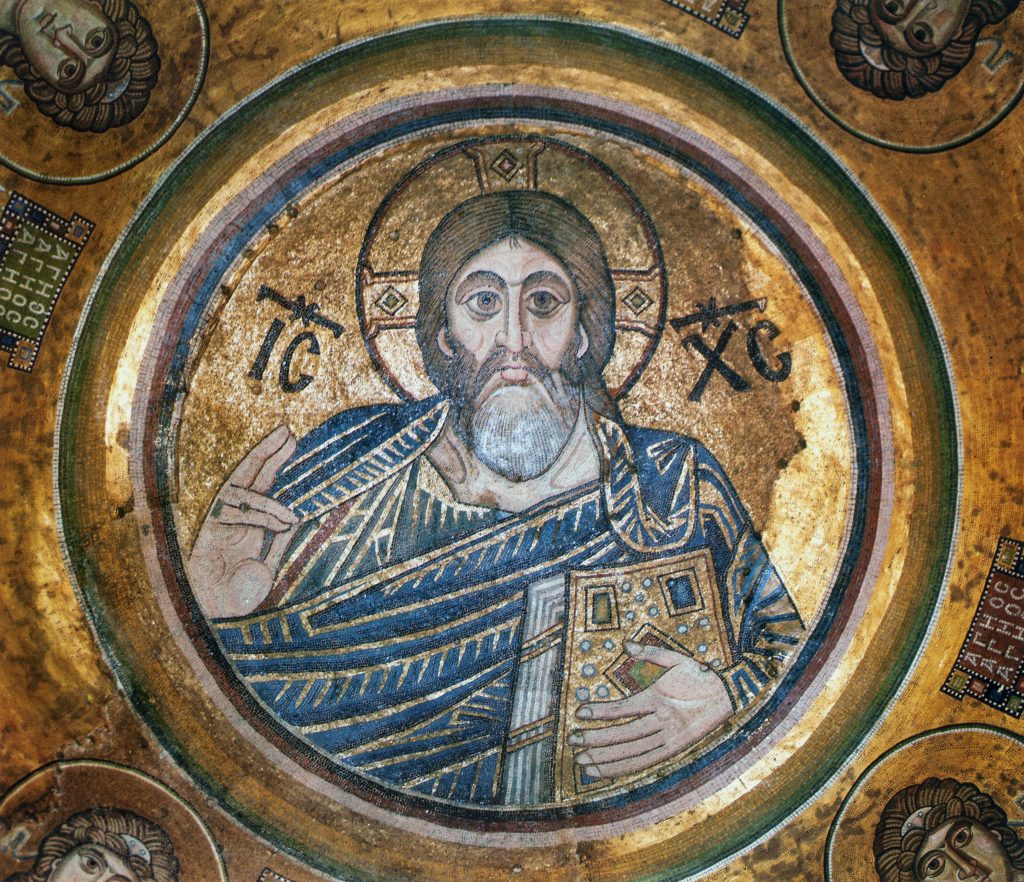
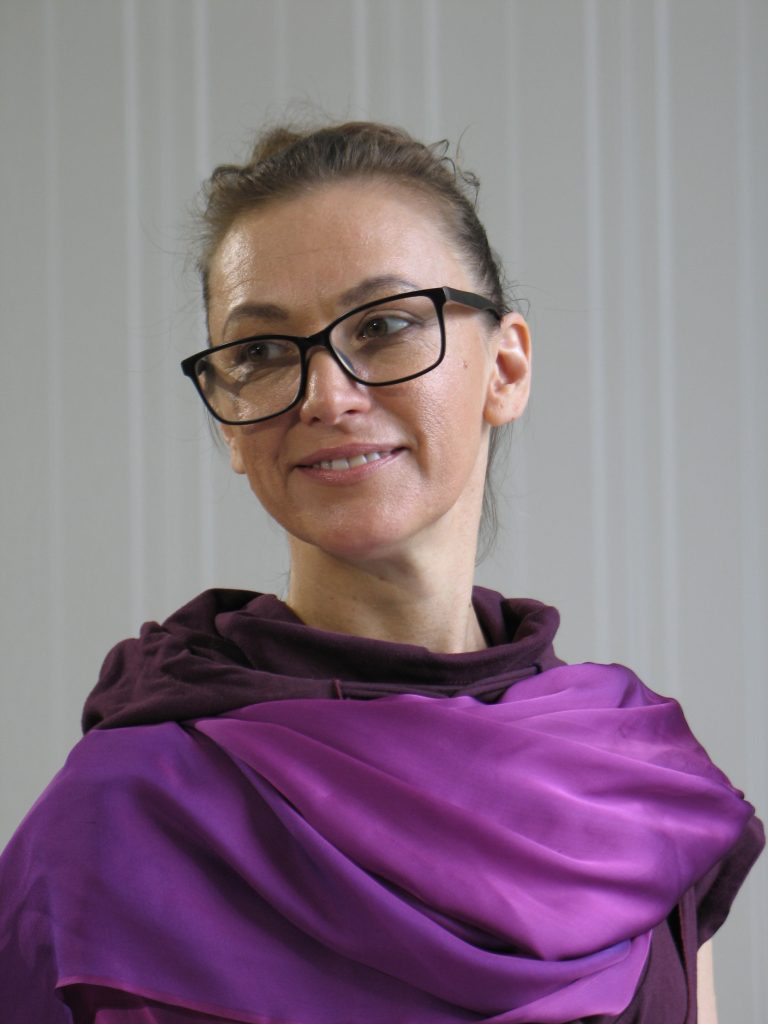
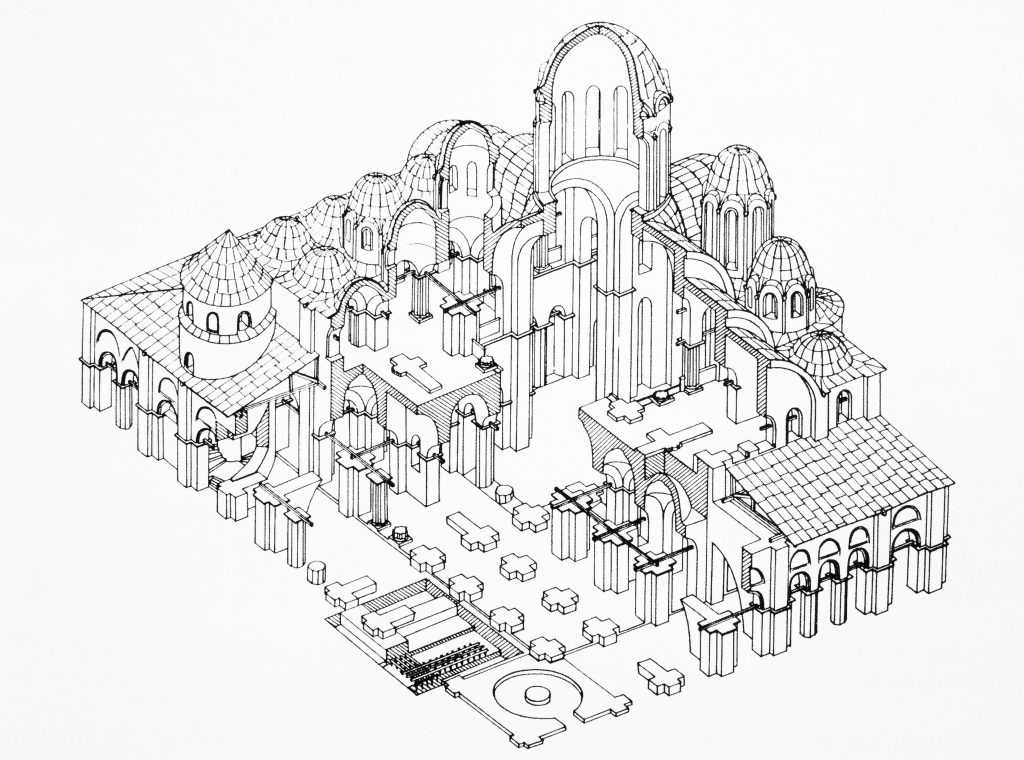
As many Index subscribers know, reducing subscription fees for the Index of Medieval Art database has been an institutional priority since the launch of its new digital platform in 2017. Because the Index budget, which supports the work of seven full-time staff members as well as a program of respected publications and conferences, relies in part on subscription revenue, such reductions have had to be gradual. But they have continued, and as we approach the five-year mark, we’re very pleased to announce that our institutional subscription fee for the coming fiscal year will be $500 per year, one third of the $1500 per annum paid by institutions when the reductions began.
We recognize that access to online resources has become increasingly important as a global pandemic and ongoing budget pressures continue to reshape teaching, learning, and research in higher education. We hope that this further fee reduction will help more institutions choose to make the Index available to their scholarly communities. Should you wish to discuss a free trial or subscription to the Index, please contact office coordinator Fiona Barrett (fionab@princeton.edu).
Continuing a series of blog posts introducing the new features of our online database.
The Index of Medieval Art database catalogs more than 26,000 subjects. For a long time, you could explore this vast taxonomy only by browsing the subject headings in alphabetical order. To make the data more accessible, the Index has developed a Subject Classification browse tool, which allows researchers to discover Index holdings by browsing through various categories of our hierarchical classification of subjects.
In this network, subjects are grouped under five top-level headings:
By browsing the contents of these categories, researchers can learn more about Index subjects as grouped by theme. Researchers interested in the “History” category, for example, will encounter individual subjects, such as the names of historical figures and their associated scenes within a medieval society, grouped under classifications such as “Heraldry,” “Donors,” “Founders,” and “Nobility.” Other groups in this category include “Those Who Pray” (including representations of religious clergy, pilgrims, missionaries, hermits and heretics), “Those Who Fight” (with admirals, generals, officers, etc.), “Those Who Rule” (with emperors, empresses, doges, despots, prefects, etc.), and “Those Who Work” (including medieval occupations by type, such as philosophers, physicians, and scholars).
The category “Religious Subjects” contains diverse subject matter, mainly figures and scenes, but also objects and rituals, not only for the three Abrahamic faiths of Christianity, Judaism, and Islam, but also for several other ancient religions, such as Greek, Roman, and Egyptian mythology. The unsurprisingly large iconographic groups for the Life of Christ and the Life of the Virgin Mary, which include the names of individual biblical figures and saints as well as biblical scenes, live in this part of the network and represent a wealth of catalogued examples in the database. Under “Religious Subjects,” biblical scenes are also grouped by their numbered books and chapters. These classifications allow researchers who are broadly interested in the iconography from a biblical source, such as the Genesis narrative, to access “Biblical Books” then “01. Genesis, Book,” and then go to a specific category. For example, the category “Genesis, Chapter 04” lists subjects of related figures and scenes appearing in Genesis 4, such as those for Adam, Eve, Cain, and Abel. Each biblical book with associated iconography in the database can be browsed for associated subject headings, including the subjects for the Psalms (following the Vulgate numbering 1–150). Researchers pursuing iconography related to texts other than the Bible will want to browse the “Literature and Legends” category, accessed from “Non-Biblical Texts” under “Society and Culture,” which contains subjects relating to the Trojan War, the Aeneid, the Legend of the Argonauts, and Arthurian Legend, among others.
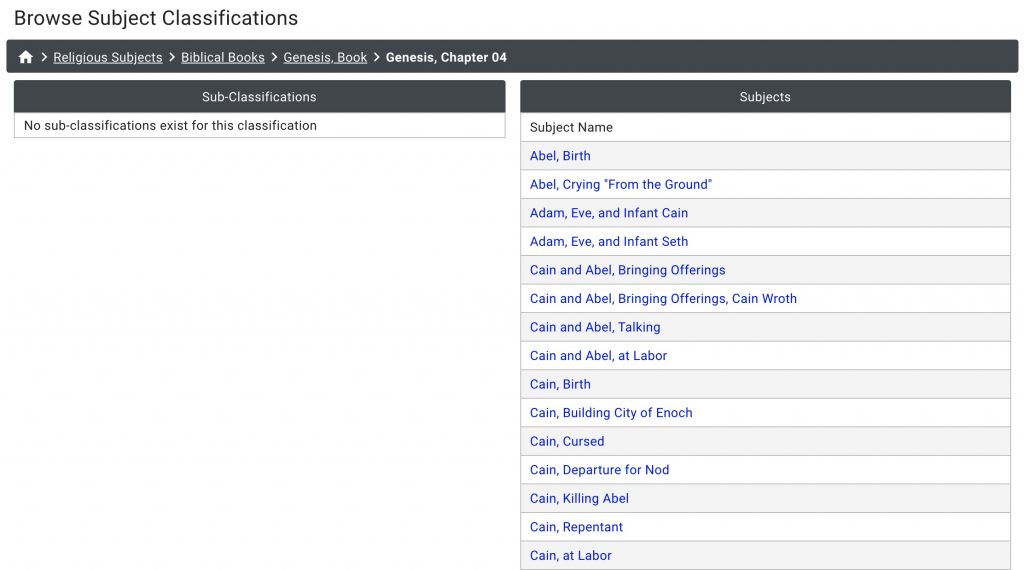
The “Society and Culture” category contains a wide variety of subject terms for representations of medieval daily life. Here you will find types of work, garments, objects, utensils, musical instruments, and furniture that the Index has identified in medieval works of art, plus an array of occupational activities, such as travel, sports, eating and feasting, and hunting scenes. Exploring the category “Sports and Games” might yield unexpected names of pastimes enjoyed in the Middle Ages. Subject terms for games such as “Chess” or “Draughts” are familiar, but others, such as “Whirligig,” might invite a deeper look.

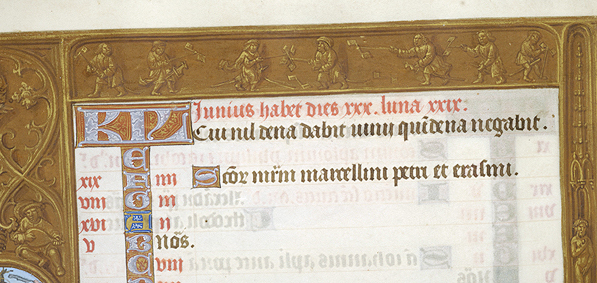
The “Nature” category is a treasure trove for anyone interested in medieval representations of animals, plants, geography, and astronomy. Here you will also find fascinating mythological creatures and hybrid figures alongside visualizations of the seasons, climate, and natural disasters. The “Symbol, Concept, and Ornament” category contains subjects for the more abstract topics in the Index collection. It currently organizes representations of allegories by name and personifications by type, including human characters for the arts, nature, places, time, virtues and vices. This category also includes maps and diagrams, monograms of individual figures, and various kinds of figured, floreate, and foliate ornament.

More a network than a strict hierarchy, the Subject Classification tool is designed to be flexible in its groupings, because the Index of Medieval Art recognizes that medieval iconography does not always fit into predetermined categories or may fit into many categories. For example, Charlemagne, the Carolingian King of the Franks and later Emperor of the Romans was also revered as a saint in some locations, so he appears in multiple parts of the network, including:
When clicking on the lowest-level subject heading, in this case “Charlemagne,” a new page will appear displaying this subject heading’s authority record. The authority record provides an array of useful information, including a Note field at the top offering a definition of the subject, or biographical details, followed by expandable fields containing select bibliographic citations, External References (cross-references to other authorities) and See Froms (alternative names and spellings of the subject). At the bottom of each subject authority is the Associated Works of Art field, an expandable field containing links to all the medieval works of art that feature this iconography.
The authority record’s Subject Classifications field presents the lowest network category, or categories, to which the subject belongs. In the example of “Charlemagne,” it is the name of the individual figure. In other instances, the Subject Classifications for a particular subject might appear on the authority as a broader grouping term. For example, the subject authority for “Drinking Horn” will use the subject classification “Utensils and Objects D–H,” and the subject for “Robin” will use the classification “Birds H–Z.” As noted in the example for biblical books, the subject classifications can also contain names of textual sources, including legends and other narratives.
The evolution of the Subject Classification tool is ongoing, allowing for continuous discovery by both those who use it and those who are building it. As branches of the network spread, new and surprising associations emerge, revealing the richness of the Index’s subject taxonomy. We hope you will enjoy browsing the iconographic headings with this new database tool, which is openly accessible to anyone who visits the browse page of the Index of Medieval Art database.
The Index of Medieval Art Subject Classifications comprises a browsable network that organizes and associates subject terms from our vast taxonomy of medieval iconography. These classifications are descriptive and not prescriptive of medieval works of art cataloged into the Index collection. What follows is an outline of the top three levels of classifications to give Index researchers the broadest overview of subject content.
Heraldry
Heraldic Symbols
Heraldry of Miscellaneous Figures and Families
Identified Heraldry A–Z
Legendary Heraldry A–Z
Historical Figures
Donors A–Z
Founders A–Z
Nobility
Those Who Fight
Those Who Pray
Those Who Rule
Those Who Work
Animals
Birds A–Z
Hunting and Other Scenes
Insects and Invertebrates
Mammals A–Z
Marine Creatures
Reptiles and Amphibians
Astronomy and Astrology
Constellations
Planets and Other Celestial Objects
Sun and Moon
Zodiac
Geography and Geology
Landscape
Minerals and Gems
Mountains
Natural Elements
Rivers
Sea and Ocean
Weather and Natural Disasters
Mythological Creatures and Hybrids
Animal Hybrids
Hybrid Figures
Mythological and Religious Creatures
Plants
Plants and Flowers A–Z
Trees and Their Fruits A–Z
Time
Months
Seasons
Times of the Day
Biblical Books
Genesis, Book–Maccabees, Book
Matthew, Book–Apocalypse, Book
Christianity
Angels and Devils
Christian Legends
Christian Objects and Rituals
Christian Religious Orders and Offices
Death and Afterlife
Divine Manifestations
Images and Attributes of Christ
Life of Christ
Life of the Virgin Mary
New Testament Apocrypha
New Testament Figures
Old Testament Apocrypha
Old Testament Figures
Saints
Types of the Virgin Mary
Greek and Roman Mythology
Mythological Figures A–Z
Mythological Narratives
Islam
Muslim Objects and Rituals
The Life of Muhammad
Judaism
Jewish Biblical Figures and Narratives
Jewish Objects and Rituals
Other Ancient Religions
Egyptian Deities
Gnosticism
Mithraism
Zoroastrianism
Architecture
Cities A–Z
Identified Buildings A–Z
Models of Buildings and Cities
Unidentified Buildings and Structures A–Z
Drollery
Drolleries and Grotesques
Figure Types
Ethnic, National, Religious, and Social Types
Figure Types A–Z
Human Hybrids
Hybrid Figures
Imaginary Figures
Labors of the Month
Months
Furniture
Bed, Bench, Lectern, Throne, etc.
Garments and Accessories
Hats, Headgear, Jewelry, etc.
Human Activities
Eating and Feasting
Hunting and Other Scenes
Medicine and Medical Practices
Occupational A–Z
Social Activities
Sports and Games
Travel and Commerce
Non-Biblical Texts
Literature and Legends
Objects and Rituals
Christian Objects and Rituals
Jewish Objects and Rituals
Muslim Objects and Rituals
Utensils and Objects
Musical Instruments A–Z
Utensils and Objects A–Z
Warfare
Arms and Armor
Military Figures
Military Scenes
Allegories and Personifications
Allegories
Personifications of Arts
Personification of Christological, Symbolic, and Literary Concepts A–Z
Personifications of Nature
Personifications of Places
Personifications of Time
Personifications of Vices
Personifications of Virtues
Maps and Diagrams
Alchemical, Alphabetical, Geometric, Astronomical Diagrams, etc. and Maps
Monogram
Monograms of Individual Figures A–Z and Symbols
Ornament
Animal, Figured, Floreate, and Foliate Ornament
In northern climes, the beginning of February used to be reliably miserable. It was always the time of year when the sedentary heart of winter was covered in forgetful snow, and we took refuge indoors while the wasteland outside was feeding a little life with dried tubers (to paraphrase T.S. Eliot). Groundhog Day is in early February for a reason. Every year, in our collective longing for an early return of spring, we eagerly anticipate the meteorological insights of a skittish marmot. And so, despite the unseasonably warm temperatures in Princeton this week, we couldn’t help but explore some imagery traditionally associated with the month of February.

In many manuscript calendar illustrations, the occupational image for February depicts an interior scene, a room in which figures warm themselves before a fireplace. Seated at the hearth, a female servant, or perhaps the woman of the house, stokes the fire. Often in such scenes, a man sits at a table spread with food and dishes. The Index of Medieval Art subject heading identifies this scene as the “Labors of the Month, February.” Certain components of this subject, such as “Fireplace,” “Table,” and “Feasting,” also have their own subject designations.
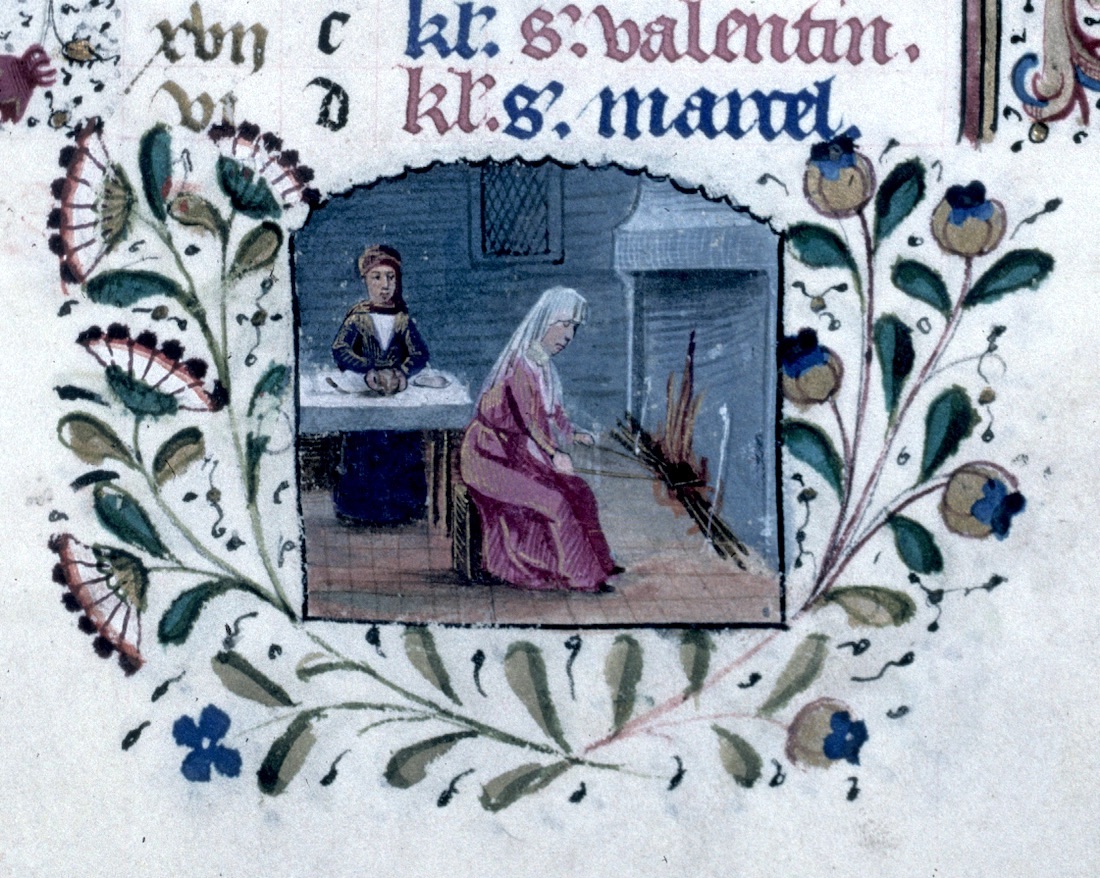
Other attributes common to the February warming scenes are figures performing such actions as blowing a bellows at the fire, cooking food in a pot over the flames, carrying bundled firewood indoors, or wearing heavy furs. A marginal miniature in the calendar of a fifteenth-century Book of Hours from Burgundy depicts a typical February scene with several of these domestic elements: a woman wearing a veiled headdress stokes a glowing fire in a simple stone fireplace while, behind her, a warmly dressed man seated at a draped table clings to a morsel of food (Fig. 1).
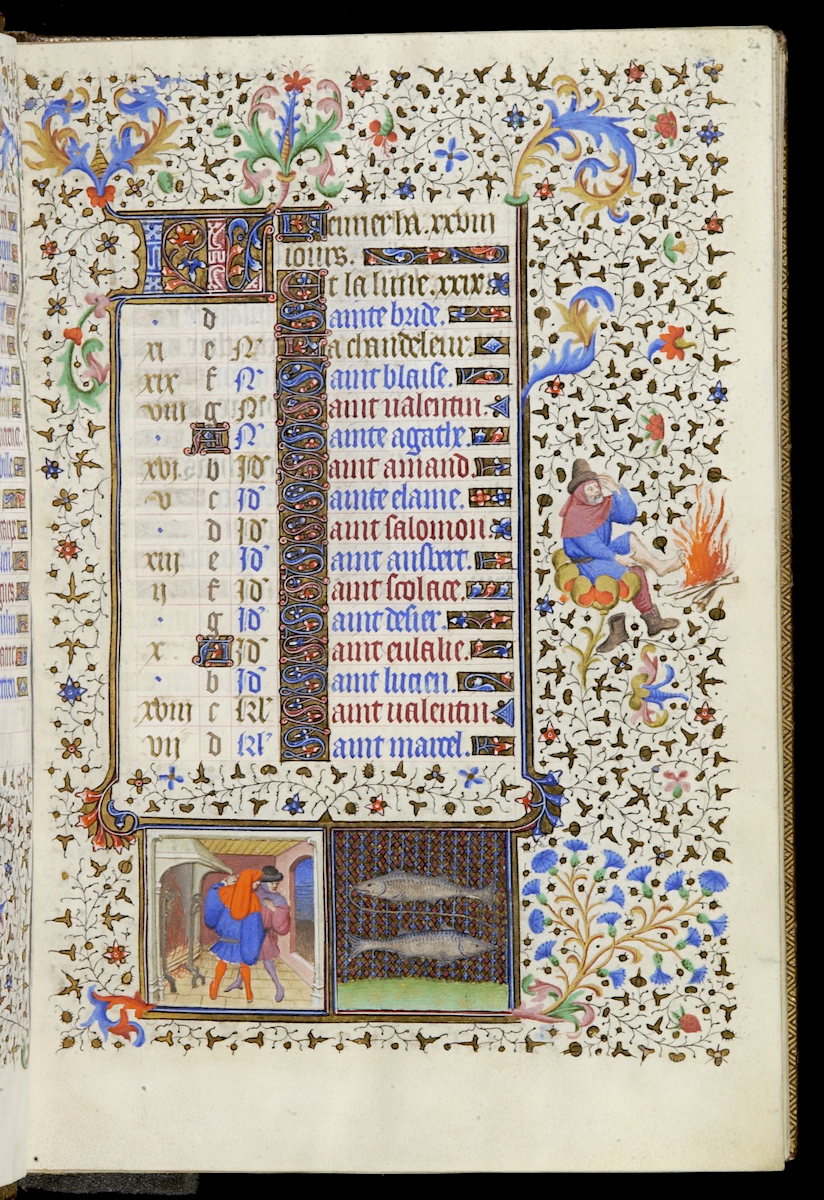
Searching the Index of Medieval Art database with simple keywords such as “fireplace,” and using the Subject Filter for “Labors of the Month, February,” will return a little more than seventy work of art records. Most of them appear in illuminated manuscripts. One such fifteenth-century Book of Hours from Paris or Flanders contains a February calendar page with two square miniatures of equal size in the lower margin. One of these paired miniatures shows the typical interior occupation of February, figures by the fire. The other shows the usual zodiac sign, Pisces, as a pair of fish lying head to tail with a line connecting them by their mouths. In the right margin, the artist created a comical moment: among the densely scrolled foliate borders, a man sitting on a fantastic flower raises his bare left foot toward some blazing logs (Fig. 2). In February, even marginalia need to warm their toes!
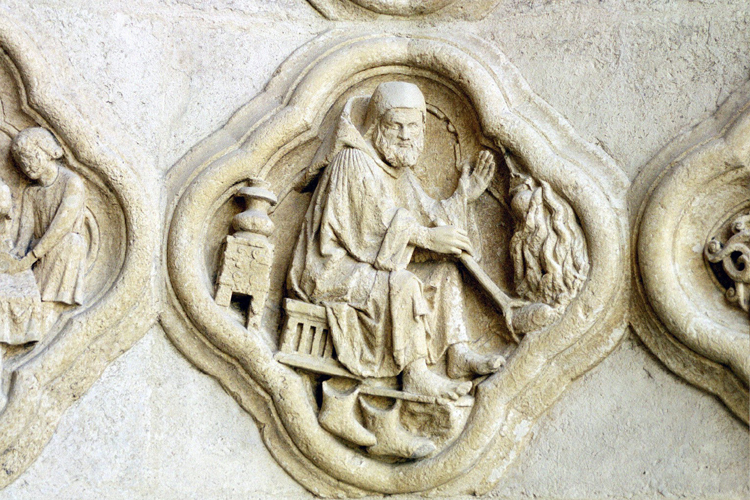
Other database filters will discover results illustrating February in different media, such as a man warming himself in the quatrefoil stone relief sculpture on the west façade of Amiens Cathedral. While this February figure sits and adjusts logs on the fire, his shoes are neatly placed in the foreground (Fig. 3). As is common for all twelve labors of the months, iconographic variants occur among these images, and monthly tasks are not fixed. Indoor cold weather occupations—including feasting, cooking, and baking—can be found in the previous months of January and December, often in similar compositions with fireplaces. February illustrations may also show outdoor scenes, such as slaughtering animals, fishing, digging fields, or pruning vines.
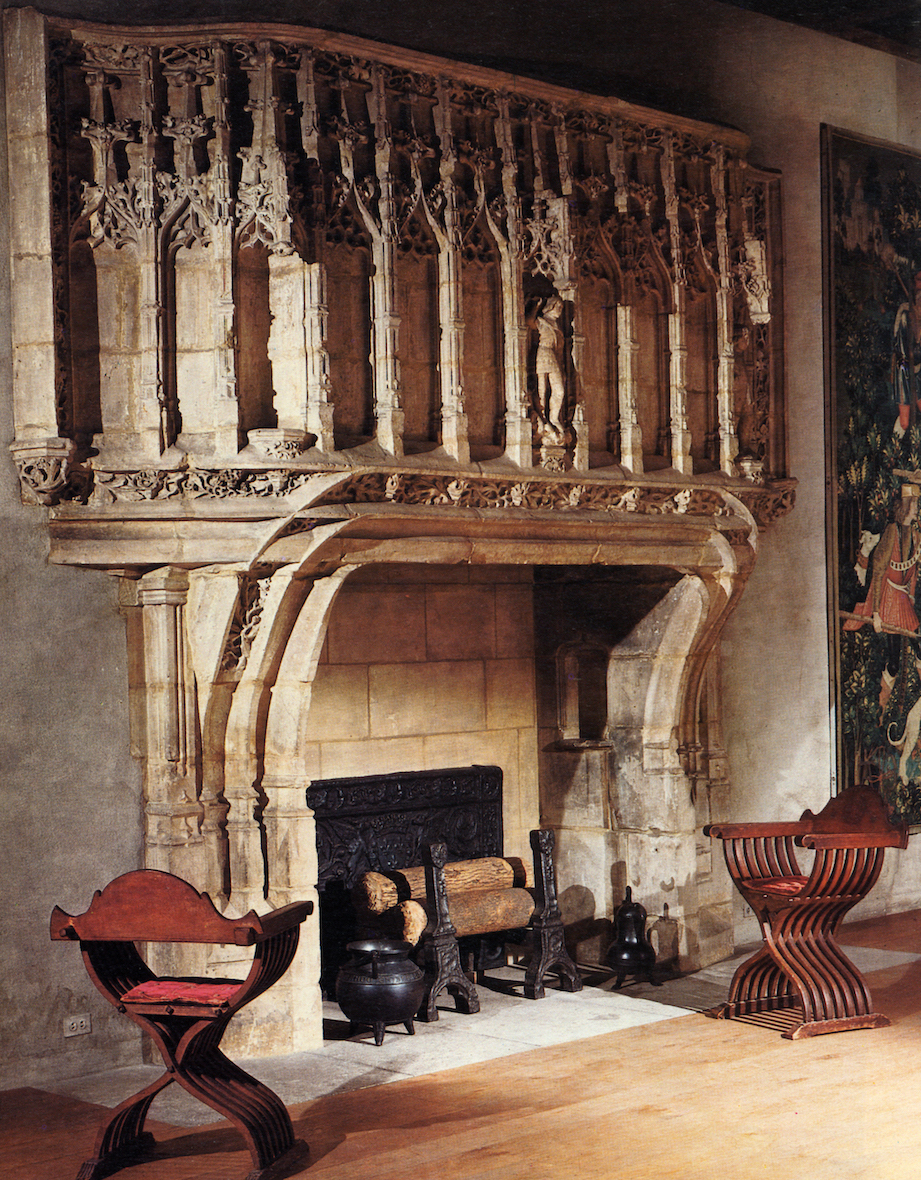
Keeping warm and dry during the winter months was a matter of survival for medieval people. Even today our good health and happiness are at risk in the winter. While its fires are long extinguished, this fine fifteenth- or sixteenth-century French limestone fireplace, today on display in the Met Cloisters, was likely once the architectural centerpiece of a home, and we can still imagine its appealing warmth (Fig. 4). Whether you are enjoying a restfully sedentary season or the official start of the spring semester has you thoroughly engaged in your own labors of the month, we wish you a warm and happy February!
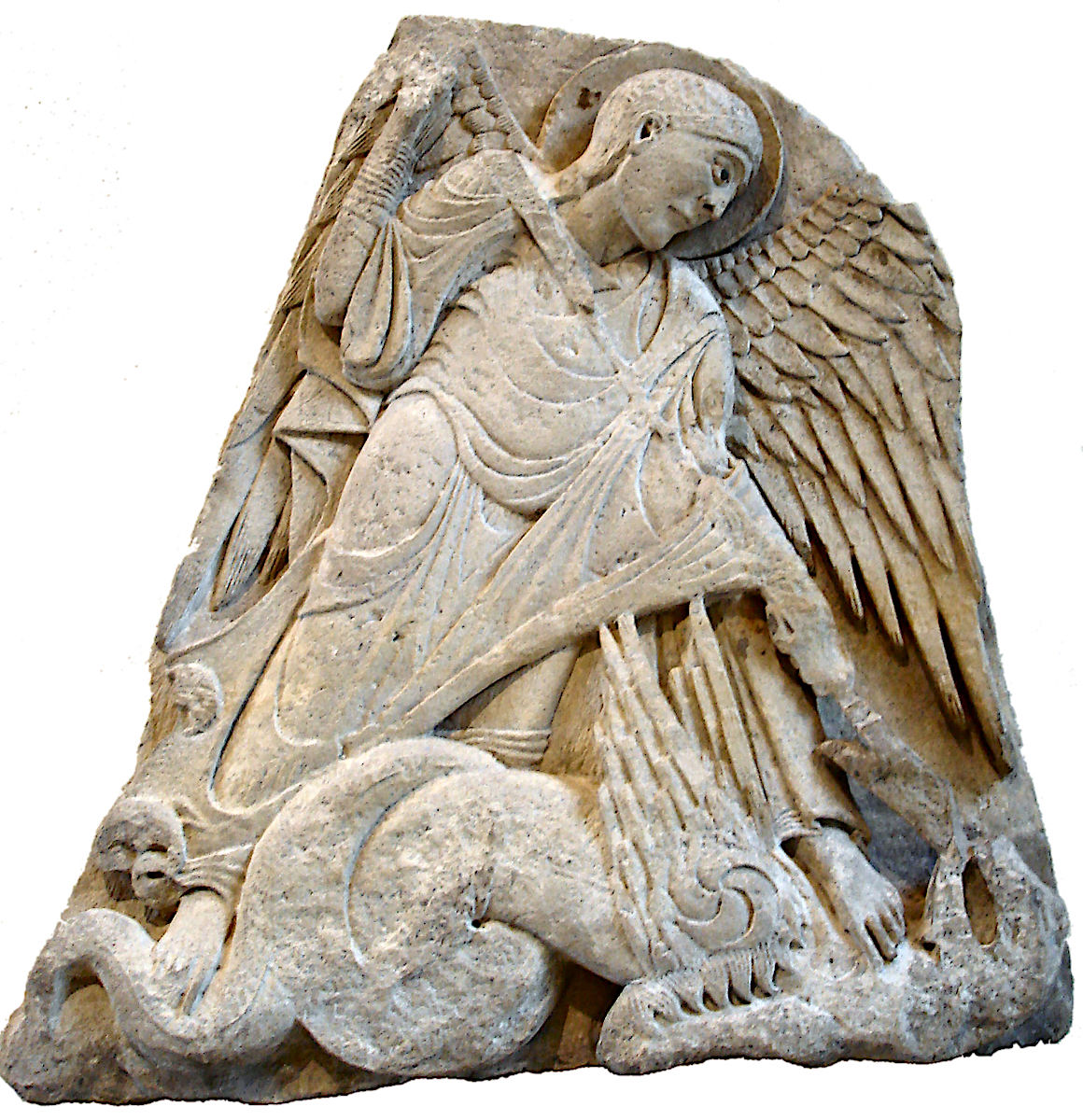
As a victorious angel, defender, and leader of heavenly armies, Michael the Archangel is often depicted in medieval art as an armored soldier carrying such arms as a cross-inscribed shield, cross-staff, or the sword or spear he typically employs to fight the dragon in the “great battle of heaven” (Apocalypse 12:7–9; see the Index subject Apocalypse, Dragon Attacked by Michael). Outside of the apocalyptic combat scene, Michael also may be shown trampling and piercing the dragon as part of his overall iconography. This figuration of Michael as the triumphant archangel lent a devotional and meditative aspect to his veneration as an overcomer of evil, as is often clear in images related to the Christian feast of Michaelmas. The feast’s name in English derived from “Michael’s Mass” and is traditionally observed in some Western churches on the 29th of September. While Michaelmas was primarily celebrated to acknowledge the works of Michael the Archangel, this feast also celebrated the help and intercession of all angels. Michaelmas also bore secular significance for medieval people as a “quarter day” of the financial year, which signaled the fulfillment of various business obligations, and the close of the agricultural year (For more on this holiday, see Ben Johnson, Michaelmas, The Blog of Historic UK).

At this time of Michaelmas, a dive into the online collection of the Index of Medieval Art reveals a wealth of examples tied to the iconography of the revered archangel. The most common representation is of Michael the Archangel fighting the dragon. In the language of the Index, that’s Michael the Archangel, Transfixing Dragon. This subject heading is attached to nearly 300 works of art in the database applied to a variety of media, including a Romanesque limestone relief panel from Burgundy, now in the Louvre Museum in Paris (Fig. 1). A closely related subject, Michael the Archangel, Transfixing Satan, is applied to works of art in which the dragon has morphed into a devilish creature, usually shown with horns and clawed feet. Like the hapless dragon, this creature is similarly impaled and trampled! Exploring these two similar subjects reveals a later preference for the literal depiction of devils in place of dragons. Michael the Archangel also features in other important episodes, such as the biblical narrative of the Fall of Angels and the Last Judgment of Christ (Figs. 2 & 3). In Last Judgment scenes, Michael the Archangel is often shown holding the scales of justice laden with good and bad souls (See the Index subject Weighing of Soul).

A fifteenth-century alabaster panel from England combines many aspects of Michael’s typical iconography: here, wearing a suit of armor that resembles feathers, he also bears a shield and raises his sword over the vanquished dragon. One weighing pan of his scales remains, holding a devil head, while behind him, a crowned Virgin intercedes to emphasize mercy with justice (Fig. 4).
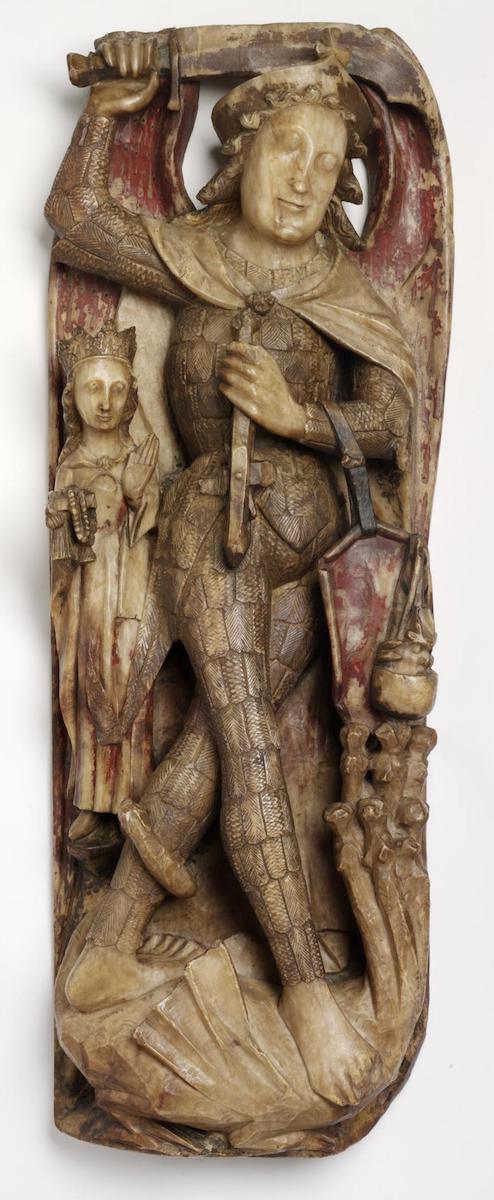
In the Index database, Michael the Archangel is by far the best represented of the archangels, with thirteen subjects covering his various roles, from intercessor and commanding soldier to apparition in visions and legends. A common legendary context for Michael is that of the “Runaway Bull” in the Golden Legend. According to the legend, a wayward bull belonging to Garganus, a wealthy man from Siponto, is miraculously saved from the shot of an arrow, which instead reversed in midair and killed the huntsman. As an explanation for this strange occurrence, Michael the Archangel appears to a local bishop to reinforce the idea of grace at the bull’s saving and to tell him to build a church in his honor (Fig. 5). The hilltop sanctuary of San Michele del Gargano is still a popular site of pilgrimage in the town of Monte Sant’Angelo in southern Italy.
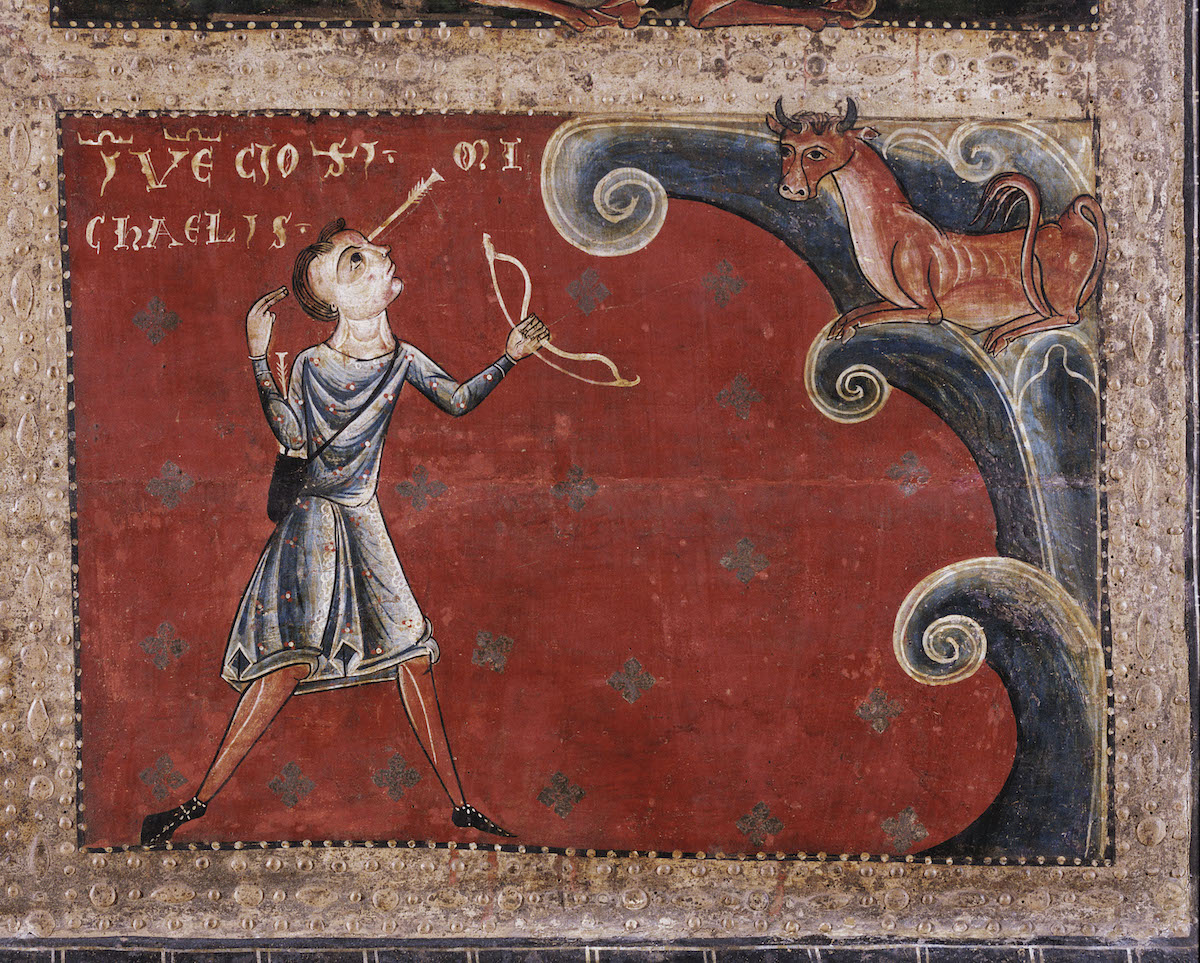
For a more general overview of the iconography of angels in the Index database, we encourage you to browse sections of the new subject classification network by clicking “Browse” and proceeding to the link for “Subject Classification.” From here, click on Religious Subjects, then Christianity, then Angels and Devils. In the sub-group of Angels, you will encounter a list of over twenty iconographic headings associated with various angels, including seraphs, cherubs, and several more subjects for angels engaged in specific actions, such as “Protecting Soul” and “Pursuing Devil.” On the left are further divisions for the four major archangels of Christian angelology—Gabriel, Raphael, Uriel, and Michael—which list the individual subjects related to each. At the bottom of each authority for these subjects, you’ll see a bar for “Work of Art References” that will take you to the relevant work of art records.
